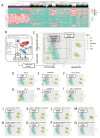Exploring Multi-Target Therapeutic Strategies for Glioblastoma via Endogenous Network Modeling
- PMID: 40244148
- PMCID: PMC11989339
- DOI: 10.3390/ijms26073283
Exploring Multi-Target Therapeutic Strategies for Glioblastoma via Endogenous Network Modeling
Abstract
Medical treatment of glioblastoma presents a significant challenge. A conventional medication has limited effectiveness, and a single-target therapy is usually effective only in the early stage of the treatment. Recently, there has been increasing focus on multi-target therapies, but the vast range of possible combinations makes clinical experimentation and implementation difficult. From the perspective of systems biology, this study conducted simulations for multi-target glioblastoma therapy based on dynamic analysis of previously established endogenous networks, validated with glioblastoma single-cell RNA sequencing data. Several potentially effective target combinations were identified. The findings also highlight the necessity of multi-target rather than single-target intervention strategies in cancer treatment, as well as the promise in clinical applications and personalized therapies.
Keywords: endogenous network theory; glioma; landscape; multi-target therapy; system biology.
Conflict of interest statement
The authors declare no conflicts of interest.
Figures


Similar articles
-
Toward precision medicine in glioblastoma: the promise and the challenges.Neuro Oncol. 2015 Aug;17(8):1051-63. doi: 10.1093/neuonc/nov031. Epub 2015 May 1. Neuro Oncol. 2015. PMID: 25934816 Free PMC article. Review.
-
Uncovering therapeutic targets for glioblastoma: a systems biology approach.Cell Cycle. 2007 Nov 15;6(22):2750-4. doi: 10.4161/cc.6.22.4922. Epub 2007 Aug 20. Cell Cycle. 2007. PMID: 17986864 Review.
-
Pharmacometabolomics Informs Quantitative Radiomics for Glioblastoma Diagnostic Innovation.OMICS. 2017 Aug;21(8):429-439. doi: 10.1089/omi.2017.0087. OMICS. 2017. PMID: 28816643 Review.
-
Exploring the prognostic value and potential therapeutic strategies of MS4A6A in glioblastoma: A comprehensive analysis of single-cell and multi-omics data.J Cell Mol Med. 2024 Oct;28(20):e70177. doi: 10.1111/jcmm.70177. J Cell Mol Med. 2024. PMID: 39470579 Free PMC article.
-
Identifying glioblastoma gene networks based on hypergeometric test analysis.PLoS One. 2014 Dec 31;9(12):e115842. doi: 10.1371/journal.pone.0115842. eCollection 2014. PLoS One. 2014. PMID: 25551752 Free PMC article.
References
-
- Louis D.N., Perry A., Reifenberger G., von Deimling A., Figarella-Branger D., Cavenee W.K., Ohgaki H., Wiestler O.D., Kleihues P., Ellison D.W. The 2016 World Health Organization Classification of Tumors of the Central Nervous System: A Summary. Acta Neuropathol. 2016;131:803–820. doi: 10.1007/s00401-016-1545-1. - DOI - PubMed
-
- Dewdney B., Jenkins M.R., Best S.A., Freytag S., Prasad K., Holst J., Endersby R., Johns T.G. From Signalling Pathways to Targeted Therapies: Unravelling Glioblastoma’s Secrets and Harnessing Two Decades of Progress. Signal Transduct. Target. Ther. 2023;8:400. doi: 10.1038/s41392-023-01637-8. - DOI - PMC - PubMed
MeSH terms
Grants and funding
LinkOut - more resources
Full Text Sources
Medical

